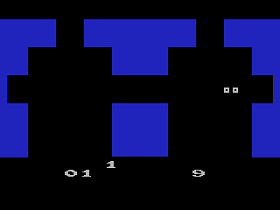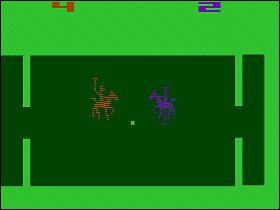 The Game: Climb onto your trusty four-legged ride for a good old fashioned game of horse hockey. Try to knock the ball into your opponent’s goal, but don’t put yourself in a position where you can’t defend your own. (Atari, 1978)
The Game: Climb onto your trusty four-legged ride for a good old fashioned game of horse hockey. Try to knock the ball into your opponent’s goal, but don’t put yourself in a position where you can’t defend your own. (Atari, 1978)
Memories: One of the earliest Atari VCS games to go unreleased, Polo was never intended for general release as its own game; rather, plans were apparently afoot within Atari to offer the game as a premium giveaway item to buyers of Ralph Lauren’s recently-introduced Polo cologne. (If that sounds a little difficult to believe, keep in mind that, in its early heyday, the $200 VCS was very much a high-end luxury item – not unlike Ralph Lauren’s products.)

 The Game: Video pinball is back, and now in more than one color! Bomb Bee takes the game mechanics of Gee Bee and makes them noisier and brighter, adding “bumper traps” that can keep the ball bouncing in tight cul-de-sacs, racking up massive bonus points with every strike. (Namco, 1979)
The Game: Video pinball is back, and now in more than one color! Bomb Bee takes the game mechanics of Gee Bee and makes them noisier and brighter, adding “bumper traps” that can keep the ball bouncing in tight cul-de-sacs, racking up massive bonus points with every strike. (Namco, 1979)


 The Game: Players get behind the wheel of a roaring race car, viewed from overhead, as it navigates a series of roads and occasional tunnels whose width varies dramatically. Tunnels are illuminated only by headlights, which means that collisions with other cars are, if not certain, then at least much more likely. Any collision results in the player’s car having to get into traffic again from a dead standstill at the side of the road. (Sega, 1979)
The Game: Players get behind the wheel of a roaring race car, viewed from overhead, as it navigates a series of roads and occasional tunnels whose width varies dramatically. Tunnels are illuminated only by headlights, which means that collisions with other cars are, if not certain, then at least much more likely. Any collision results in the player’s car having to get into traffic again from a dead standstill at the side of the road. (Sega, 1979)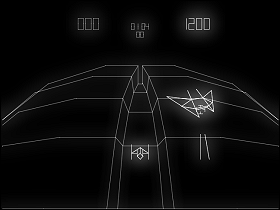 The Game: The player pilots a space fighter into an endless dogfight above a space station trench. Enemy ships attack from all directions, and even zip down the trench; and and all of these can be blasted into bits for points. Beware the fastest of these enemy fighters, which will appear with very little notice and fire directly at the player’s score, relieving it of points every time the fighter is successful with its attack! (Cinematronics, 1979)
The Game: The player pilots a space fighter into an endless dogfight above a space station trench. Enemy ships attack from all directions, and even zip down the trench; and and all of these can be blasted into bits for points. Beware the fastest of these enemy fighters, which will appear with very little notice and fire directly at the player’s score, relieving it of points every time the fighter is successful with its attack! (Cinematronics, 1979) The Game: This may sound awfully familiar, but you’re the lone surviving pilot of a space squadron decimated by enemy attacks. The enemy’s bow-tie-shaped fighters are closing in on you from all sides, and you must keep an eye on your own fighter’s shields, weapon temperature (overheated lasers don’t like to fire anymore), and ammo, all while trying to draw a bead on those pesky enemy ships. You’re also very much on your own – nobody’s going to show up and tell you you’re all clear, kid. (Exidy, 1979)
The Game: This may sound awfully familiar, but you’re the lone surviving pilot of a space squadron decimated by enemy attacks. The enemy’s bow-tie-shaped fighters are closing in on you from all sides, and you must keep an eye on your own fighter’s shields, weapon temperature (overheated lasers don’t like to fire anymore), and ammo, all while trying to draw a bead on those pesky enemy ships. You’re also very much on your own – nobody’s going to show up and tell you you’re all clear, kid. (Exidy, 1979) The Game: Pull the plunger back and fire the ball into play. The more bumpers it hits, the more points you rack up. But don’t let the ball leave the table – doing so three times ends the game. (Atari, 1979)
The Game: Pull the plunger back and fire the ball into play. The more bumpers it hits, the more points you rack up. But don’t let the ball leave the table – doing so three times ends the game. (Atari, 1979)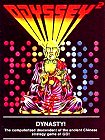 The Game: Purporting to be based on the ancient Chinese game of Go, Dynasty! is actually more of a variation of Othello. The same strategies apply, and can be played with two players, one against the computer, or – for those who are feeling a little bit lazy – the computer vs. itself. (Magnavox, 1979)
The Game: Purporting to be based on the ancient Chinese game of Go, Dynasty! is actually more of a variation of Othello. The same strategies apply, and can be played with two players, one against the computer, or – for those who are feeling a little bit lazy – the computer vs. itself. (Magnavox, 1979)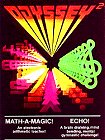 The Game: Wow! We must be in the future, for we now have electronic flash cards! This is more or less the function fulfilled by Math-A-Magic, while Echo is a slightly watered down version of the classic electronic game Simon. (Magnavox, 1979)
The Game: Wow! We must be in the future, for we now have electronic flash cards! This is more or less the function fulfilled by Math-A-Magic, while Echo is a slightly watered down version of the classic electronic game Simon. (Magnavox, 1979)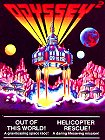 The Game: In this two-for-one game, you take to the skies in one of two different ways. Out Of This World! is a classic lunar lander game, in which you must balance your descent speed and your remaining fuel to make a safe landing on the surface of the moon, and then safely return to dock with your command module in orbit again. Helicopter Rescue! is a simplistic game in which you pilot a helicopter, trying to retrieve as many people as possible from a doomed hotel and take them safely to a nearby ground station. Precision and timing are of the essence. (Honestly, though, we never see what’s wrong with that hotel – there’s no evidence of fire, terrorists, massive fiddygibber infestations…) (Magnavox, 1979)
The Game: In this two-for-one game, you take to the skies in one of two different ways. Out Of This World! is a classic lunar lander game, in which you must balance your descent speed and your remaining fuel to make a safe landing on the surface of the moon, and then safely return to dock with your command module in orbit again. Helicopter Rescue! is a simplistic game in which you pilot a helicopter, trying to retrieve as many people as possible from a doomed hotel and take them safely to a nearby ground station. Precision and timing are of the essence. (Honestly, though, we never see what’s wrong with that hotel – there’s no evidence of fire, terrorists, massive fiddygibber infestations…) (Magnavox, 1979) The Game: As a lone space pilot flying down a seemingly endless trench, your job is simple – blast or bomb all of the vaguely-bow-tie-shaped space fighters that you see. If your fighter is on the lower half of the screen, you’re blasting straight ahead/upward; if you move your fighter near the top of the screen, you can bomb any fighters below you. The game ends when you run out of ships; fortunately you never seem to run out of ammo. (Bally, 1979)
The Game: As a lone space pilot flying down a seemingly endless trench, your job is simple – blast or bomb all of the vaguely-bow-tie-shaped space fighters that you see. If your fighter is on the lower half of the screen, you’re blasting straight ahead/upward; if you move your fighter near the top of the screen, you can bomb any fighters below you. The game ends when you run out of ships; fortunately you never seem to run out of ammo. (Bally, 1979)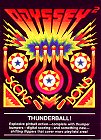 The Game: It’s all the thrills of pinball, minus approximately 75% of the excitement! Use your joystick to control the plunger tension and launch your ball into play. Use the action button to pop the flippers, keeping your ball on the field and out of trouble. The bumpers and spinner score big points…well, relatively speaking. (Magnavox, 1979)
The Game: It’s all the thrills of pinball, minus approximately 75% of the excitement! Use your joystick to control the plunger tension and launch your ball into play. Use the action button to pop the flippers, keeping your ball on the field and out of trouble. The bumpers and spinner score big points…well, relatively speaking. (Magnavox, 1979) The Game: Why worry about space invaders when there are more pressing earthly threats? Players guide a mobile cannon at the bottom of the screen, trying to take out a constant barrage of balloon bombers dropping live bombs. A direct hit to the cannon costs the player a “life,” but if the player allows a bomb to hit bottom, the results can be almost as dangerous: bombs crater the surface that the player’s cannon moves across, and allowing those pits to collect on the surface can severely limit the player’s movements, to the point of leaving the cannon a motionless sitting duck for the next round of balloon bombs, or a plane that periodically drops cluster bombs from overhead. (Taito, 1980)
The Game: Why worry about space invaders when there are more pressing earthly threats? Players guide a mobile cannon at the bottom of the screen, trying to take out a constant barrage of balloon bombers dropping live bombs. A direct hit to the cannon costs the player a “life,” but if the player allows a bomb to hit bottom, the results can be almost as dangerous: bombs crater the surface that the player’s cannon moves across, and allowing those pits to collect on the surface can severely limit the player’s movements, to the point of leaving the cannon a motionless sitting duck for the next round of balloon bombs, or a plane that periodically drops cluster bombs from overhead. (Taito, 1980)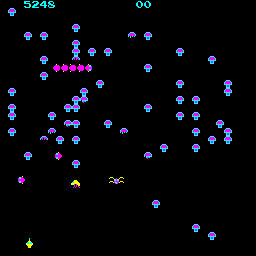
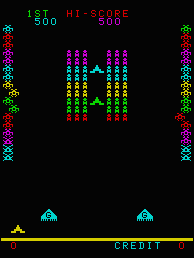 The Game: The invaders are back, and this time they plan on making quick work of Earth’s defenses. Columns of alien invaders descend from space, staying safely outside of the range of the player’s cannon. A few aliens at a time break formation and attempt to reach the player’s floating stockpiles of ordnance and extra ships floating in the center of the screen; if the aliens are able to reach these items, the player will lose a life. The only option is to take out the invaders before they succeed. (Universal, 1980)
The Game: The invaders are back, and this time they plan on making quick work of Earth’s defenses. Columns of alien invaders descend from space, staying safely outside of the range of the player’s cannon. A few aliens at a time break formation and attempt to reach the player’s floating stockpiles of ordnance and extra ships floating in the center of the screen; if the aliens are able to reach these items, the player will lose a life. The only option is to take out the invaders before they succeed. (Universal, 1980) The Game: The good news: Darwin was right, evolution is a thing. The bad news: this does not work in your favor. You man a laser cannon trying to intercept alien insects making their way toward the bottom of the screen; at the most inconvenient times, the bugs revert to a pupal stage during which they’re either impossible to hit or invulnerable. They then emerge in a newer, faster, deadlier form bent on destroying you. (Universal, 1980)
The Game: The good news: Darwin was right, evolution is a thing. The bad news: this does not work in your favor. You man a laser cannon trying to intercept alien insects making their way toward the bottom of the screen; at the most inconvenient times, the bugs revert to a pupal stage during which they’re either impossible to hit or invulnerable. They then emerge in a newer, faster, deadlier form bent on destroying you. (Universal, 1980) The Game: In a heavily armed space fighter, your job is pretty simple – ward off wave after wave of bird-like advance fighters and Phoenix creatures until you get to the mothership, and then try to blow that to smithereens. All of which would be simple if not for the aliens’ unpredictable kamikaze dive-bombing patterns. The
The Game: In a heavily armed space fighter, your job is pretty simple – ward off wave after wave of bird-like advance fighters and Phoenix creatures until you get to the mothership, and then try to blow that to smithereens. All of which would be simple if not for the aliens’ unpredictable kamikaze dive-bombing patterns. The 
 The Game: Players are manning the defenses of a space station under a constant onslaught from all sides by alien attackers. The station’s laser cannons can take out the alien ships and intercept their incoming fire; when an entire wave of attackers is eliminated, a much more mobile fighter will attack, and destroying it will advance the game to the next level of difficulty. (Midway,1980)
The Game: Players are manning the defenses of a space station under a constant onslaught from all sides by alien attackers. The station’s laser cannons can take out the alien ships and intercept their incoming fire; when an entire wave of attackers is eliminated, a much more mobile fighter will attack, and destroying it will advance the game to the next level of difficulty. (Midway,1980) The Game: You’re trapped in a symmetrical maze with a bevy of robotic target vehicles – “Targs” – which are programmed to do just one thing: collide with your vehicle. You have one advantage on these decidedly mean streets, however – you can fire missiles ahead of your car (but the Targs are capable of dodging your projectiles too, so don’t get too cocky). Every once in a while, one of the impregnable blocks in the maze will disgorge a new enemy which is just a little bit faster and deadlier than the rest. Clearing the screen of Targs advances you to a new level with faster enemies – and eventually they’ll put the brakes on your attempts to survive. (Exidy, 1980)
The Game: You’re trapped in a symmetrical maze with a bevy of robotic target vehicles – “Targs” – which are programmed to do just one thing: collide with your vehicle. You have one advantage on these decidedly mean streets, however – you can fire missiles ahead of your car (but the Targs are capable of dodging your projectiles too, so don’t get too cocky). Every once in a while, one of the impregnable blocks in the maze will disgorge a new enemy which is just a little bit faster and deadlier than the rest. Clearing the screen of Targs advances you to a new level with faster enemies – and eventually they’ll put the brakes on your attempts to survive. (Exidy, 1980) The Game: As a yellow sailor man consisting of a head and nothing else (jaundice was really bad in those days), you maneuver around a relatively simple maze, gobbling small dots and evading four colorful monsters who can eat you on contact. In four corners of the screen, large flashing dots enable you to turn the tables and eat the monsters for a brief period for an escalating score. The monsters, once eaten, return to their home base in ghost form and return to chase you anew. If cleared of dots, the maze refills and the game starts again, but just a little bit faster… (unknown bootleg manufacturer, 1980)
The Game: As a yellow sailor man consisting of a head and nothing else (jaundice was really bad in those days), you maneuver around a relatively simple maze, gobbling small dots and evading four colorful monsters who can eat you on contact. In four corners of the screen, large flashing dots enable you to turn the tables and eat the monsters for a brief period for an escalating score. The monsters, once eaten, return to their home base in ghost form and return to chase you anew. If cleared of dots, the maze refills and the game starts again, but just a little bit faster… (unknown bootleg manufacturer, 1980)

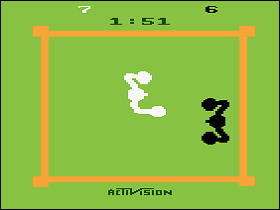
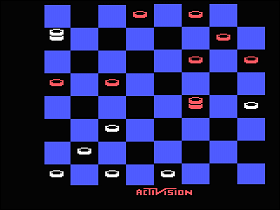 The Game: The classic game of strategy is faithfully reproduced on the
The Game: The classic game of strategy is faithfully reproduced on the  The Game: You control a clown on a moving see-saw, launching your fellow clown into the air to pop balloons and defy gravity. But what goes up must come down, and your airborne clown, if he doesn’t bounce upward upon impact with
The Game: You control a clown on a moving see-saw, launching your fellow clown into the air to pop balloons and defy gravity. But what goes up must come down, and your airborne clown, if he doesn’t bounce upward upon impact with 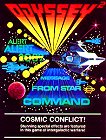 The Game: This is a very simple first-person space game in which you watch various and sundry harmless space freighters waft lazily past your screen, punctuated at regular intervals by TIE-fighter-like attackers which do pose a moderate threat to you (but not much of a moderate threat). (Magnavox, 1980)
The Game: This is a very simple first-person space game in which you watch various and sundry harmless space freighters waft lazily past your screen, punctuated at regular intervals by TIE-fighter-like attackers which do pose a moderate threat to you (but not much of a moderate threat). (Magnavox, 1980)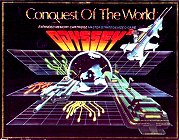 The Game: In probably the weakest of the Master Series games – Odyssey games which included overcomplicated board game elements, a la Quest For The Rings – you control one of the world’s superpowers, attempting to gain as much influence as possible through political and economic means and, where necessary, warfare. (Magnavox, 1980)
The Game: In probably the weakest of the Master Series games – Odyssey games which included overcomplicated board game elements, a la Quest For The Rings – you control one of the world’s superpowers, attempting to gain as much influence as possible through political and economic means and, where necessary, warfare. (Magnavox, 1980)
